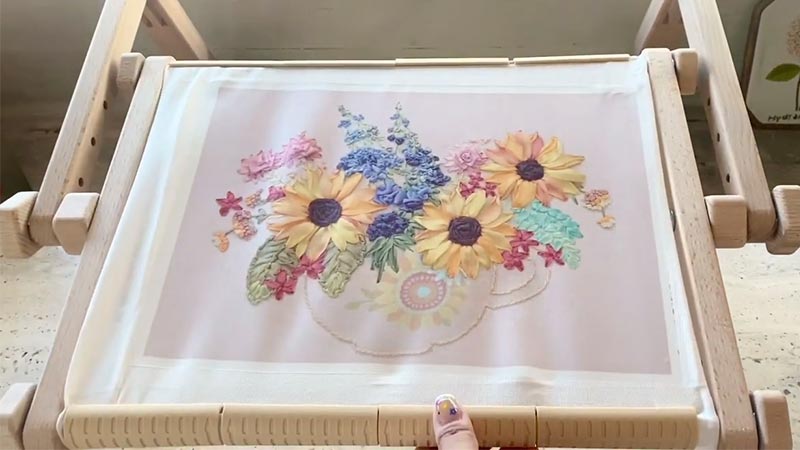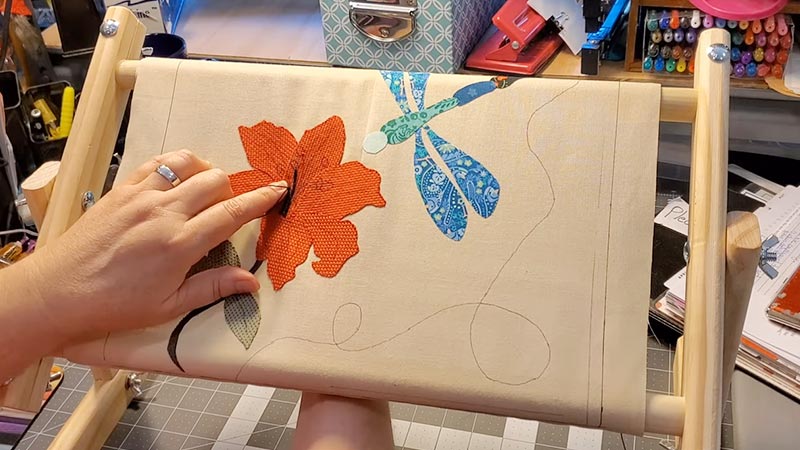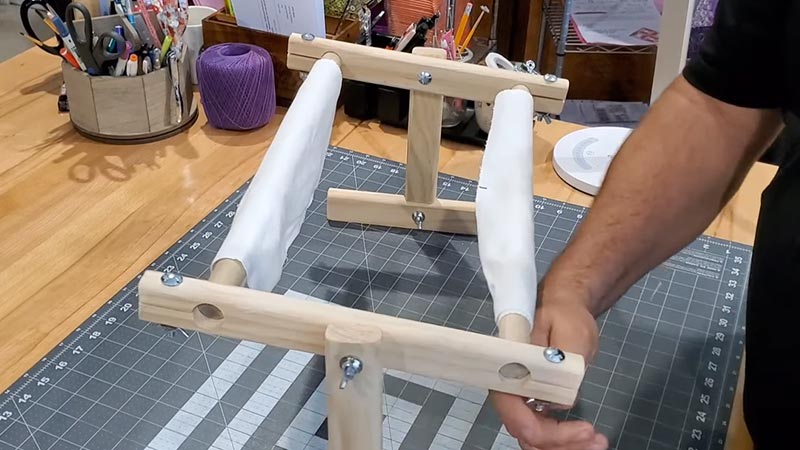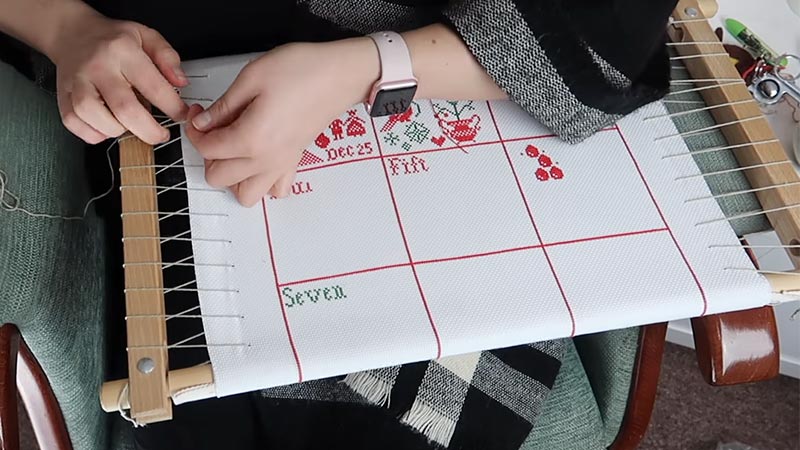Using a scroll frame is a game-changer for cross-stitch enthusiasts, providing a stable and efficient platform for intricate projects.
This specialized tool, consisting of two parallel rods, offers a means to secure the fabric tautly, ensuring precise stitching.
By attaching the fabric to the frame, stitchers can easily maneuver through different sections of their design, eliminating the need for constant adjustments.
This guide will walk you through the steps of using a scroll frame effectively, from preparing your fabric to mastering techniques that enhance your cross-stitch experience.
Discover the benefits and techniques to elevate your cross-stitch projects with this comprehensive guide.

What Is Scroll Frame?
A scroll frame is a specialized tool used in needlework, particularly for cross stitch and embroidery projects. It consists of two parallel rods, typically made of wood or plastic, one at the top and one at the bottom.
The fabric is attached to these rods, keeping it taut and secure. This tensioned fabric allows for precise and accurate stitching.
Scroll frames are especially useful for larger or complex designs, as they prevent fabric distortion and ensure even tension across the entire piece.
They enable the needleworker to move through different project sections easily, rolling the fabric as needed. Some scroll frames can be attached to stands or clamps for hands-free stitching, enhancing comfort during long crafting sessions.
How to Use a Scroll Frame for Cross-Stitch?
Using a scroll frame for cross-stitching is an effective way to keep your fabric taut and organized while working on your cross-stitch project.
Scroll frames consist of two rods, one at the top and one at the bottom, that hold your fabric securely in place.
This method is particularly useful for larger and more complex cross-stitch patterns, as it prevents fabric distortion and makes stitching easier.
Here’s a step-by-step guide on how to use a scroll frame for cross stitch:
Materials You’ll Need:
- Scroll frame with attached fabric
- Cross stitch pattern and chart
- Embroidery floss in desired colors
- Embroidery needle
- Small embroidery scissors
- A stand or table clamp to hold the scroll frame
Instructions:
Prepare Your Fabric
Begin by inspecting your fabric for any imperfections or stains. If necessary, iron out any wrinkles using a low heat setting. Once your fabric is smooth and clean, position it on the scroll frame. Align the top edge of the fabric with the top rod.
Use sewing pins or clips to secure it, ensuring the fabric is perfectly straight and taut.
Repeat this process for the bottom rod, ensuring the fabric is evenly tensioned across the frame.
Select Your Pattern
Take a moment to study your chosen cross-stitch pattern. Familiarize yourself with the symbols and colors used in the chart.
When working with a printed pattern, consider placing it in a well-lit area and using a magnetic board or clipboard to keep it within view. Have your computer or tablet nearby with the pattern open for easy reference for digital charts.
Thread Your Needle
Select the first color of embroidery floss you’ll be using and prepare your needle. Thread the floss through the needle’s eye, leaving a long tail to hold onto comfortably.
Start Stitching
Begin stitching according to your pattern. Remember to work in a consistent direction, whether from left to right or right to left.
As you stitch, periodically check the tension of the fabric on the scroll frame. If you notice any wrinkles or slack, adjust the tension by gently tightening or loosening the fabric on the rods.
Scroll Down
As you complete sections of your cross stitch, it will be necessary to scroll the fabric down to access the next area.
To do this, gently roll the bottom rod upwards while unrolling the top rod. Take care to ensure that the rest of the fabric remains protected and untangled as you do this.
Repeat and Maintain Tension
Continue stitching, scrolling down, and adjusting the fabric as needed. Periodically check the tension to ensure that the fabric remains taut and smooth. This step is crucial for maintaining accuracy in your stitches.
Finishing
Once you’ve finished stitching your cross-stitch project, carefully remove the fabric from the scroll frame.
Take a moment to inspect your work for any loose threads or imperfections. Trim any excess fabric, leaving enough to allow for framing or finishing as desired.
Benefits of Using a Scroll Frame

Using a scroll frame in needlework, particularly for cross stitch and embroidery, offers several notable benefits:
Taut Fabric
Scroll frames keep the fabric taut and flat, preventing wrinkles, folds, or distortions that can occur when working on larger or complex designs. This ensures accurate stitching.
Even Tension
The tension across the fabric is consistent, allowing for uniform and neat stitches. This is especially crucial for achieving a polished and professional-looking finished piece.
Easy Maneuverability
Scroll frames allow the user to easily move through different project sections by scrolling the fabric up or down. This makes it convenient to focus on specific areas without disturbing the rest of the piece.
Minimized Fatigue
Using a scroll frame with a stand or clamp can reduce hand and wrist strain, providing a hands-free option for stitching. This is particularly beneficial for longer crafting sessions.
Preservation of Work
The even tension and secure attachment in a scroll frame help protect the fabric from accidental damage, such as fraying or tearing, which can occur when using other methods.
Ideal for Larger Projects
Scroll frames are especially effective for larger or more intricate designs requiring extended stitching periods. They provide a stable platform for working on expansive projects.
Versatility
Scroll frames are compatible with various fabric types, allowing for various creative possibilities. They can accommodate different fabric sizes and types, from Aida cloth to linen.
Maintaining and Caring for the Scroll Frame

Maintaining and caring for your scroll frame is essential to ensure it remains a reliable tool for your cross stitch or embroidery projects.
Here are some tips on how to keep your scroll frame in good condition:
Regular Cleaning
Regular cleaning of your scroll frame is important for its longevity. Using a clean, slightly damp cloth, gently wipe down the rods and any other parts of the frame.
This will remove dust and debris accumulating over time and potentially affecting the frame’s performance. Be careful not to oversaturate the wood, as excessive moisture can be detrimental.
Avoid Excessive Force
Handle your scroll frame with care. Avoid applying excessive force, especially when attaching or adjusting your fabric.
Applying too much pressure could lead to warping or weakening of the rods, affecting the frame’s overall integrity.
Inspect for Damage
Take the time to inspect your scroll frame regularly for any signs of wear or damage. Look for indications such as splintering wood, loose parts, or bent rods.
Addressing any issues promptly is crucial to prevent further deterioration and ensure the frame’s longevity.
Store Properly
Proper storage is crucial for maintaining the integrity of your scroll frame. Disassemble it when it’s not in use and store it in a clean, dry location.
Avoid exposing it to extreme temperatures, as rapid changes in temperature can cause the wood to expand or contract, potentially leading to warping or weakening.
Keep Away from Pets and Children
To prevent accidental damage or injury, ensure that your scroll frame is stored out of reach of pets and small children.
This precaution helps safeguard the frame from potential mishandling, which could lead to unnecessary wear and tear.
Check Tightening Mechanism
When your scroll frame features a tightening mechanism, it’s advisable to inspect it regularly. Ensure it’s functioning smoothly and without any obstructions.
When needed, apply a small amount of lubricant to maintain its proper operation. This step helps to ensure that your scroll frame continues to operate effectively.
Replace Worn Parts
When any components of the scroll frame become damaged or show signs of extensive wear, consider replacing them.
Many scroll frame manufacturers offer replacement parts or kits, which can help restore the frame’s functionality and extend its lifespan.
Avoid Exposure to Moisture
Keep your scroll frame dry at all times. Exposure to moisture, whether from spills, high humidity, or damp conditions, can lead to warping, cracking, or mold development.
Protecting the frame from moisture is crucial for its long-term durability and performance.
Avoid Over-Tightening
While having your fabric taut is important, exercise caution to avoid over-tightening the rods.
Applying excessive force can lead to unnecessary strain on the frame, potentially causing damage over time. Strive for an even tension that keeps the fabric flat without putting undue pressure on the frame.
Lubricate Moving Parts
When your scroll frame contains movable components or a tightening mechanism, periodic lubrication can help maintain smooth operation.
Apply a small amount of suitable lubricant, such as beeswax or a silicone-based product, to ensure that all parts move freely without resistance.
This simple step can significantly prolong the life of your scroll frame and contribute to its continued effectiveness.
Tips and Tricks for Using Scroll Frames Effectively

Using scroll frames effectively in your cross stitch or embroidery projects can enhance your stitching experience and improve the quality of your finished work.
Here are some tips and tricks to help you make the most of your scroll frame:
Proper Fabric Attachment
Ensuring that your fabric is attached evenly and securely to the scroll frame is a crucial first step. Take your time to align the fabric straight and taut.
Use sewing pins or clips to hold it in place, ensuring it’s evenly distributed across the frame. This initial preparation sets the foundation for a smooth stitching experience.
Start with the Top Edge
Beginning with the top edge of your fabric allows for a logical and organized approach to your project. It aligns with the natural progression of stitching from top to bottom.
This method also facilitates an easier transition when scrolling down to access different sections of your design.
Consistent Tension
Maintaining consistent tension on your fabric is vital for achieving a clean and professional finish. Ensure that the fabric is neither too loose nor overly stretched.
Regularly check and adjust the tension as you work to prevent distortions or uneven stitches.
Use a Stand or Clamp
Investing in a stand or table clamp for your scroll frame can greatly enhance your stitching experience. It provides a stable and hands-free way to hold the frame, reducing strain on your hands and arms.
This allows for longer, more comfortable stitching sessions, which is especially beneficial for intricate or time-consuming projects.
Scroll Down Methodically
When it’s time to progress to a new section of your project, approach it methodically. Gently roll up the bottom rod while unrolling the top rod to access the next area.
This systematic scrolling ensures that your work stays organized and avoids unnecessary tangles or disruptions.
Keep the Rest Protected
While you focus on one section of your project, take care to roll the remaining fabric onto the rods.
This protective measure shields untouched areas from accidental spills, dirt, or damage, ensuring that your entire project remains pristine.
Use a Magnet Board or Highlighter Tape
For paper patterns, consider using a magnet board or highlighter tape. These tools can help you keep track of your progress on the chart, making it easier to follow the pattern and locate your current position. This visual aid streamlines the stitching process.
Organize Your Floss
Keep your embroidery floss well-organized and easily accessible. Using bobbins, floss organizers, or a designated storage system can save you time and prevent unnecessary tangles.
This organization ensures you can quickly find the right color for each stitch, leading to a smoother process.
Invest in Good Lighting
Adequate lighting is essential for accurate and comfortable stitching. Investing in a quality task light helps reduce eye strain and lets you clearly see your stitches. Proper lighting enhances the precision and overall quality of your work.
Practice Good Stitching Techniques
Pay attention to your stitching techniques, focusing on maintaining consistent stitch sizes and directions.
This attention to detail leads to a more polished and professional-looking finished piece. Consistency in your stitching creates a cohesive and visually appealing design.
Plan for Frame or Finishing
Before you begin stitching, consider how you’ll frame or finish your completed project.
Leave enough extra fabric around the design to accommodate your chosen finishing method. This foresight ensures that your project is ready for its final presentation.
FAQS
How do I attach my fabric to a scroll frame?
Start by aligning the top edge of your fabric with the top rod, then secure it with pins or clips.
What should I do if my fabric wrinkles on the scroll frame?
Adjust the tension by gently tightening or loosening the fabric on the rods to eliminate wrinkles and maintain even tension.
Is it necessary to scroll down the fabric after each section?
Yes, scrolling down is essential to access different areas of your project. Roll the bottom rod up while unrolling the top rod to keep your work organized.
Can I use a scroll frame for small cross-stitch projects?
While scroll frames are ideal for larger or intricate designs, they can be used for smaller projects if desired.
Do I need a stand or table clamp for my scroll frame?
While not mandatory, using a stand or clamp can greatly enhance your stitching experience, reducing hand fatigue during longer crafting sessions.
Wrap Up
Incorporating a scroll frame into your cross-stitch endeavors opens up a world of possibilities. Its ability to maintain fabric tension and facilitate seamless scrolling allows for greater precision and efficiency in your projects.
With proper care and attention to detail, your scroll frame will become indispensable in your crafting arsenal. Remember to inspect and clean it regularly, ensuring its longevity and functionality.
By following these steps and techniques, you’ll achieve beautifully stitched designs and experience a more enjoyable and rewarding cross-stitching journey.
Embrace the artistry and precision made possible by using a scroll frame, and watch your creations flourish.
Leave a Reply